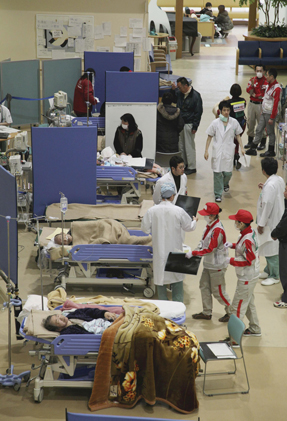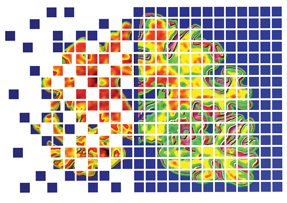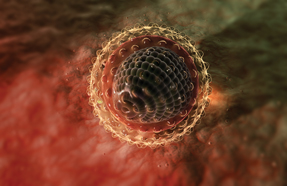Internists healing tsunami's aftereffects
Six months after an earthquake and tsunami, Japan's populace and its clinicians are sizing up the long-term health effects of the physical injuries, the mental trauma and the damage to the nation's health care facilities. Internists describe the aftermath in their own words.
On March 11, Yoshiyuki Ueno, MD, an ACP Member, a gastroenterologist at Tohoku University Hospital in Sendai, Japan, was attending a Friday afternoon staff meeting on the eighth floor when the room began to shake.
The shaking, which persisted nearly 10 minutes, was like nothing that Dr. Ueno had experienced previously. “We could guess that a tsunami was coming because the earthquake was so bad,” he said.

Once it ceased, and clinicians were told they could safely move, doctors, nurses and other hospital staffers converged for an emergency staff meeting several floors down. The 1,270-bed hospital, located in a city near the epicenter of the 2011 Tohoku earthquake, was largely spared because it was some distance from the coastline. But the hospital, like others around the country, kicked into high gear as clinicians strived to reach and treat residents nearer the coastline who had been injured and emotionally traumatized by the epic natural disaster.
Six months later, Japan's populace and its clinicians are sizing up the long-term health effects.
Following the immediate trauma-related injuries, Japanese internists and other physicians coped with related medical crises, such as helping people who required oxygen support or dialysis amid electricity disruptions and, in some cases, the shutdown of entire hospitals.
Some infections were related to the tsunami itself, and physicians also have been monitoring mental health symptoms, as well as radiation-related risk for those living closest to damaged nuclear plants.
But in the immediate days after the 9.0-magnitude earthquake and tsunami, one of the most difficult realities to grasp was how relatively few people needed urgent medical attention, said internist Gautam Deshpande, MD, an ACP Member and a physician at the U.S. Embassy in Tokyo.
In the first days and weeks after the natural disaster, which resulted in more than 15,000 deaths and thousands more missing and injured, the country's Disaster Medical Assistance Teams (DMATs) rallied, according to Dr. Deshpande. Still, as on Sept. 11, 2001 in the United States, there were relatively few people to treat, he wrote in a lengthy e-mail. “It was a ‘black tag-white tag’ situation, in that those who had perished had done so quickly on the day of the event,” he wrote.
The situation was far different than after the 1995 Kobe earthquake, which resulted in numerous trauma injuries, said Mamiko Ohara, MD, PhD, an ACP Fellow and chief of the department of nephrology at Kameda Medical Center in the Chiba Prefecture. “This disaster was mainly a tsunami disaster,” she said. “So there were really few injured people. People were dead or survived, but intact.”
Immediate crisis
During the first several days, Dr. Ueno slept at the hospital as he joined other physicians in treating patients who came into the emergency room, along with those who required gastrointestinal care.
The first day or so, there weren't many, in part because telephones were down and people couldn't call ambulances, he said. More patients were brought in once the ambulances in the center of Sendai started going out to the coastline to pick them up.

At Tohoku University Hospital, they would be triaged: dead or dying (black); severely injured (red); those who needed help right away (yellow); and those who were least hurt and could wait (green). The percentage of incoming patients classified as red or black was highest in the first day, Dr. Ueno said.
Some of the patients had fractures or injuries related to the collapse of buildings, he said. Other patients came to the hospital in need of oxygen or dialysis or because vital medication was washed away by the tsunami. During the first two weeks, Tohoku University Hospital accepted more than 100 patients who urgently needed dialysis, Dr. Ueno said. Several hospitals in the Sendai area were too damaged to stay open, he said.
Tohoku University Hospital experienced its own challenges. When it lost electricity following the earthquake, an emergency generator provided backup, but it was not sufficient to power the entire facility, including a sophisticated electronic medical record system. Some crucial drugs, such as cancer drugs, couldn't be refrigerated, Dr. Ueno reported.
Beginning a week after the earthquake, other medical problems emerged, Dr. Ueno said. Influenza and pneumonia quickly spread in the evacuation centers, and one unexpected illness was a type of severe pneumonia that was linked to swallowing flood waters. Dr. Ueno also noted an increase in stomach ulcers, some likely stress-related, which persisted as of mid-summer.
Primary intervention
In Japan, medical care has been more traditionally provided by subspecialists and the role of primary care specialists is far more limited than in the United States, according to Dr. Deshpande, also a clinical educator and clinical epidemiology researcher at St. Luke's International Hospital in Tokyo.
Relatively few generalist physicians work in the hospital setting, although some interest is developing in the hospitalist model, he wrote. Instead, subspecialty physicians are more likely to assume that role, taking care of patients' specialty needs as well as any other medical care they might require when hospitalized.
Since many patients didn't require hospital treatment, doctors and DMATs fanned out into the damaged regions of the country to provide assistance, including sometimes basic medical and mental health care. Masaharu Tsubokura, MD, a hematologist who practices in Tokyo, traveled in early April to South Soma, located near Tokyo Electric Power Company's damaged Fukushima Daiichi power plant. Part of the city fell outside the power plant's mandatory evacuation zone, but within its 30-kilometer radius, so residents were asked to remain indoors following the radiation release.
Dr. Tsubokura, who treated patients at an evacuation center and hospitals upon his arrival, said many of those staying there suffered from symptoms related to chronic disease, such as hypertension, asthma, and diabetes, among others, that had been exacerbated by a lack of medicine since the earthquake.
“All of them worried about the radiation exposure, of course,” he said. During medical checkups, he drew blood samples but didn't see any signs of immediate radiation-related effects. In the short term, at least, chronic disease symptoms were more pressing than radiation exposure, he said.
By early summer, Dr. Tsubokura was providing care at South Soma General Hospital and didn't plan to return to Tokyo until next year. The city of South Soma, which shrank to about 10,000 people at the worst of the crisis, has returned to roughly half of its typical population of 70,000, he said.
And there aren't enough doctors, he said in late June. “Many doctors and many people do not want to come to Soma because of the fear of the radiation. Someone should provide medical care for them,” he said. Asked if he's concerned about his own personal risk, he acknowledged: “A little bit.”
Dr. Deshpande, another physician who left Tokyo to help, traveled as part of a small team about three weeks after the disaster to Kesennuma, a port city that was largely washed away by the tsunami.
He had planned to remain as long as needed, but saw that the region was well staffed by DMATs. “I thought the city officials did a wonderful job in bringing them together, organizing them into subgroups and sending these subgroups out to cover evacuation sites, nursing homes and other places where evacuees were staying,” he said.
The longer horizon
Dr. Ohara, who also traveled to the coast, specifically Ishinomaki, spent several days in mid-April helping to survey the residents there to see who remained, as well as to identify their medical and social service needs.
Some people had already left the evacuation centers to return to their homes, she said, “but their home was still damaged and still in danger.” She and other clinicians visited 11,271 homes and found that 1,409 families had returned. They were frequently living on the second floor and, at that time, didn't necessarily have electricity, water or gas, she said.
Many had lost family members to the tsunami and were understandably coping with post-traumatic stress disorder, Dr. Ohara said. Other medical issues related to malnutrition and inadequate hygiene due to extensively contaminated debris.
Longer term, Dr. Ueno worries about residents' exposure to toxic substances, such as asbestos, that were released into the air from damaged buildings. Residents who return to their homes in South Soma may be exposed to residual radiation, Dr. Tsubokura said. The area is agricultural and although the government has prohibited the sale of the produce, some people are eating the vegetables that they grow, he said. “They do eat them because eating local vegetables is not prohibited.”
Such stories concern Ritsuko Komaki, MD, a professor of radiation oncology at the University of Texas M.D. Anderson Cancer Center in Houston. Depending on the exposure, some residents and particularly children may be more vulnerable in the years ahead to some cancers, such as leukemia or thyroid, she said.
But Dr. Komaki, who grew up in Hiroshima, well understands the deep ties to land in Japan, a precious commodity in the tightly packed country. Frequently land has been handed down from generation to generation, she said. “We have so much attachment to the place where we were born and the land. So it's very difficult to move people away,” she said.
As a baby, Dr. Komaki was living in another city with her immediate family when the atomic bomb was dropped on Hiroshima. Some of her relatives perished. But the family still moved back to Hiroshima when she was four and she continued to reside there until she left in her mid-20s for medical training in the United States.
Moving forward
Dr. Deshpande worries about burnout by city administrators and clinicians as they attempt to meet the ongoing demand for mental health services and social support in devastated coastal regions. Perhaps, though, the disaster will help encourage some longer-term change, he wrote.
His suggestions include broadening mental health services to encompass more cognitive behavioral techniques and talk-based interventions, rather than simply prescribing pills. He also hopes the crisis will highlight a persistent problem: poor distribution of doctors throughout the country, with too many based in the largest cities.
Compared with Americans, Japanese patients are less likely to reach out for help, particularly if they are struggling with depression, anxiety, sleeplessness and other mental health symptoms, Dr. Komaki said. Instead they may rely on prayer or meditation or attempt to suppress their distress.
“In Japan, people do not seek psychiatrists or psychologists to make their depression go away,” she said. “They just put everything inside. They don't want to show weakness, especially the men. They cry in the dark.”
As a result, the mental health support structure is far more limited than in the United States, Dr. Komaki said. Meanwhile, the psychological stress following the Tohoku earthquake is beyond comprehension. “Some of the kids went to school and never came home because the school was washed away,” she said.
Dr. Komaki, who as it happened was 10 minutes from landing in Tokyo when the earthquake hit, continues to keep in close contact with friends and colleagues in Japan. Along with discussing her medical concerns, she also relays extraordinary acts of compassion.
She described one story told by a friend, who directs a cancer center in Sendai. As the hospital filled with trauma patients, an older man who urgently needed cancer-related surgery packed up his things to leave.
“He said, ‘Please give my bed to the people who have trauma, the children. I am going home.’” But he didn't necessarily have a home anymore, Dr. Komaki said. “That means he decided to walk out and die.”





